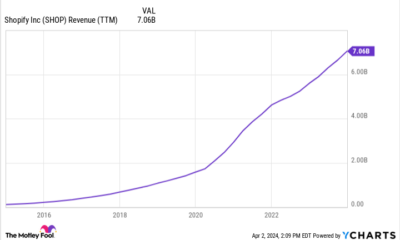MARKETING
3 Reasons To Make Personalization More Personal [Rose-Colored Glasses]
Should you try to personalize your content? Is it even possible?
Much of the content advice you’ll read says yes (while acknowledging how hard it is to do).
But a recent article in Marketing Week proclaimed personalization unachievable.
The authors cite two reasons to give up on personalization. The first is that real personalization is impossible because it assumes you have perfect data on every customer. The second “fatal flaw” (as they call it) is that personalization doesn’t work even if you have perfect data on everyone.
The authors point to “universal experiences” as the reason behind the success of the best movies and television shows. Thus, they argue, “marketers would be much better off investing in ‘performance branding’; in other words, one-size-fits-most creative that speaks to the common category needs of all potential buyers.”
These authors haven’t spent much time on TikTok.
So, let’s get honest about personalization and content.
Targeted content isn’t personalized – it’s ‘persona-ized’
Consumers want advertising and content to be more relevant and personalized – they just don’t want to notice it’s happening. Research shows most people feel creeped out, angry, or indifferent when learning that ads were presented to them based on personal details.
It’s a bit of a paradox. Ask customers if they want targeted, relevant advertising and content to help them during their buying process, and they typically say, “Yes.” But ask them if companies should use their data to do it, and they overwhelmingly say, “Hell no.”
The best content experiences aren’t conspicuously personalized. Instead, they’re personal, relevant, and welcome. They are experiences that feel like they are just for you, without overtly telling you they are. Again, think TikTok. The algorithm slowly personalizes the feed for you, but it doesn’t tell you that it’s “optimized.” It just is.
However, personalization – certainly at the level most businesses can achieve – is rarely personal. Most techniques use collected data to parrot back what the brand has learned from you. For example, you might see “Hello [Robert], you’ve purchased [these products], therefore you might want to learn about [this concept].” Yes, it might be accurate, but it hardly makes you feel like they know you. This approach also doesn’t scale well. The article gets this part right.
Think about what you’re trying to do with personalization. You’re trying to deliver the right message to the right person at the right time.
The challenge isn’t that the customer data is bad – most organizations can identify people and collect accurate information about them. It isn’t in dynamically assembling the content – technology can handle that.
The problem lies in the sheer enormity of content needed to address every right message and when to deliver it. What ends up happening is that the right person gets the only message available – usually at the wrong time. That equates to a personalization #FAIL.
Most organizations serve the right person the only message they have – usually at the wrong time. That’s a #Content personalization fail, says @Robert_Rose via @CMIContent. Click To Tweet
Too often, personalization feels like a game of Mad Libs, where you simply insert the data you have into the content you have to show the consumer that you know who they are.
But that’s when personalization calls attention to itself – and starts to feel creepy. The whole house of cards falls – and marketers throw up their hands in frustration.
Personal, not personalized
Most marketers would be better off trying to create content that’s personal, not personalized.
People don’t act on or share a piece of content because it’s personalized with “Hello [NAME]” (even when the Name field contains the correct name). The content people want to share is something that moves them to say, “Hey, you all have to check this out!” They share content that makes them recognize something about themselves and believe others will see themselves in it, too.
When your audience says, “Wow, this is exactly what I needed,” you win.
When your audience says your content is exactly what I needed is when you know you’ve won, says @Robert_Rose via @CMIContent #ContentMarketing Click To Tweet
I’m not saying personalization won’t work. I’m saying most content marketers should focus on giving people content that feels like it’s just for them, but they don’t know (or care) why.
I recently wrote about the value of listening to your audience before talking to them. Listening is a solid foundational step toward targeted content.
Keep these three things in mind as you build your targeted content approach:
1. Personal doesn’t require demographic data
Context matters most when you’re targeting content to people using technology. Asking why someone wants your thought leadership builds more trust than asking for their identifying demographic information. Even better: The answer helps you serve them the “best next experience.”
2. Personalization is best served invisibly (at least at first)
Personalized content makes people feel like they’re in the “uncanny valley,” a term that describes the weird feeling you get when you see a humanish computer-generated image or robot.
The Marketing Week article speaks to the clumsiness of technology and the failure of accurate data at serving the “wrong” content. But having the right data and technology can cause an audience to say, “WTF?” if the personalization calls attention to itself.
You know that feeling you get when you see an ad on Facebook for something you only mentioned in passing to your spouse? Personalization that gets noticed gives people that exact feeling.
3. Personal should grow into personalized as trust builds
The closer a person gets to becoming a customer, the more personalized the message should become. As you learn more about the person, addressing them one-to-one becomes critical. It makes sense to deliver a wide-open experience when you first encounter prospects so they can see themselves in the breadth of your content. (That approach tracks with what the Marketing Week article called “performance branding.”)
The closer a person gets to becoming a customer, the more personalized the message should become, says @Robert_Rose via @CMIContent. Click To Tweet
As you develop a relationship, the conversation should become more specific. When it’s time to sign on the dotted line (and ever after), the communications should be as “personalized” as possible.
Superficial won’t cut it
As you assemble your content marketing strategy, think less about superficially personalizing content. Instead, focus on creating content that makes a broad audience say, “That’s exactly what I needed,” regardless of what cookies they have or don’t have on their machines.
First-party data helps you understand the context and get better at targeting by creating an audience you can listen to. So keep collecting that data.
But ask yourself whether using it to create a personalized experience really will help you create a personal experience.
Yes, use technology to the max. Yes, devise strategies that scale. But stay in touch with what works for human beings. And what works for human beings is content that has so much value that they want to pass it on. Personally.
HANDPICKED RELATED CONTENT:
Get Robert’s take on content marketing industry news in just three minutes:
https://www.youtube.com/watch?v=videoseries
Cover image by Joseph Kalinowski/Content Marketing Institute
!function(f,b,e,v,n,t,s)
{if(f.fbq)return;n=f.fbq=function(){n.callMethod?
n.callMethod.apply(n,arguments):n.queue.push(arguments)};
if(!f._fbq)f._fbq=n;n.push=n;n.loaded=!0;n.version=’2.0′;
n.queue=[];t=b.createElement(e);t.async=!0;
t.src=v;s=b.getElementsByTagName(e)[0];
s.parentNode.insertBefore(t,s)}(window, document,’script’,
‘https://connect.facebook.net/en_US/fbevents.js’);
fbq(‘init’, ‘1432232210459613’);
fbq(‘track’, ‘PageView’);



















You must be logged in to post a comment Login